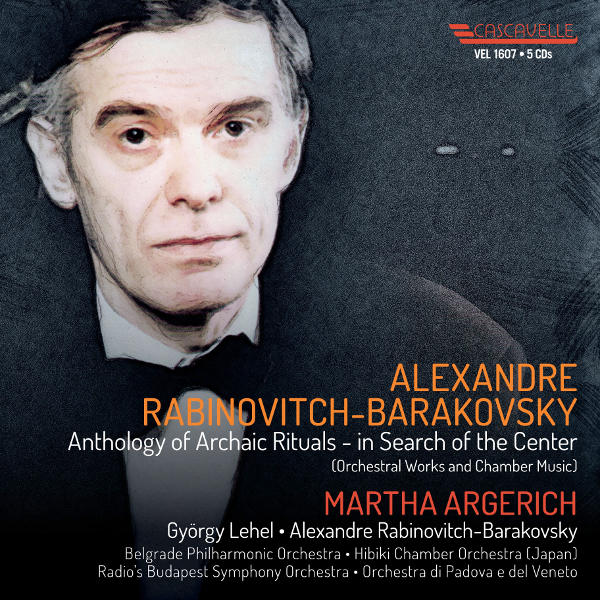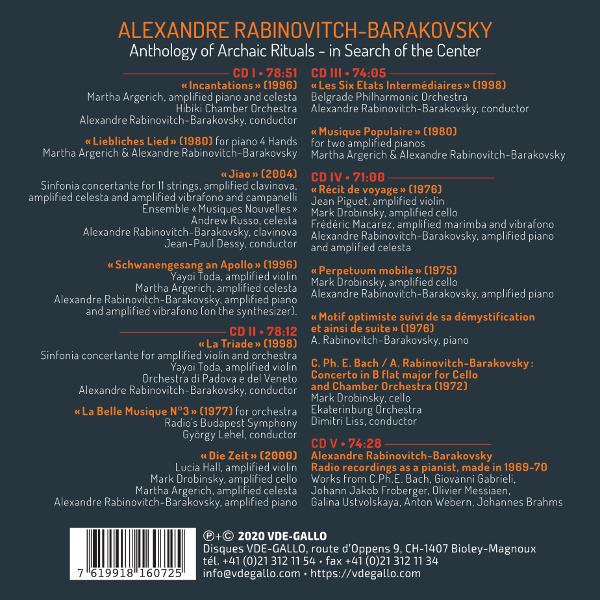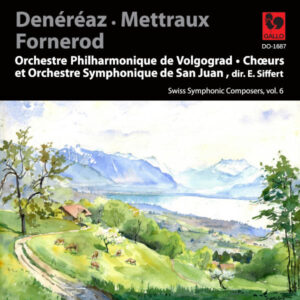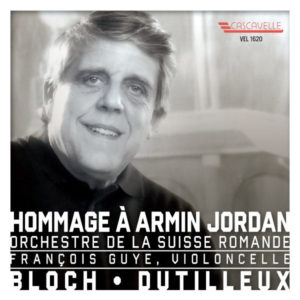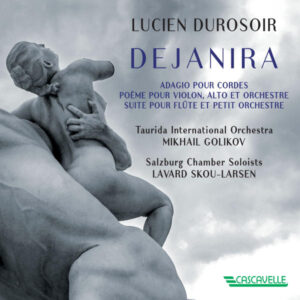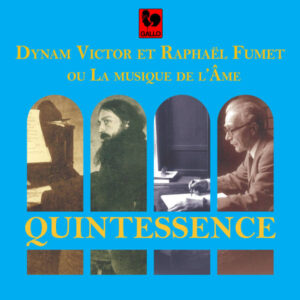Extraits / Excerpts
ALEXANDRE RABINOVITCH-BARAKOVSKY : ANTHOLOGY OF ARCHAIC RITUALS – IN SEARCH OF THE CENTER, MIT MARTHA ARGERICH, CELESTA & KLAVIER (5 CD BOX)
Alexandre Rabinovitch-Barakovsky: Anthology of Arcaic Rituals – In Search of the Center – mit Martha Argerich, Klavier
CD 1 :
Alexandre RABINOVITCH-BARAKOVSKY :
Incantations.
Martha Argerich, amplified Piano and Celesta, Hibiki Chamber Orchestra, Alexandre Rabinovitch-Barakovsky, Conductor.
Liebliches Lied (For Piano 4 hands).
Martha Argerich & Alexandre Rabinovitch-Barakovsky, Piano four Hands.
Sinfonia Concertante: Jiao (Live).
Andrew Russo, Celesta, Alexandre Rabinovitch-Barakovsky, Clavinova, Musiques Nouvelles, Jean-Paul Dessy, Conductor.
Schwanengesang an Apollo (Live).
Yayoi Toda, amplified Violin, Martha Argerich, amplified Celesta, Alexandre Rabinovitch-Barakovsky, amplified Piano and amplified Vibrafono.
CD 2 :
Alexandre RABINOVITCH-BARAKOVSKY :
La Triade: I. Le Deuil (Live) – La Triade: II. La Trance (Live) – La Triade: III. Le Silence (Live).
Yayoi Toda, amplified Violin, Orchestra di Padova e del Veneto (website), Alexandre Rabinovitch-Barakovsky, Conductor.
La Belle Musique No. 3, for Orchestra (Live).
Budapest Radio Symphony Orchestra, György Lehel, Conductor.
Die Zeit: I. L’élan (Live) – Die Zeit: II. L’horloge (Live) – Die Zeit: III. La durée (Live).
Lucia Hall, amplified Violin, Mark Drobinsky, amplified Cello, Martha Argerich, amplified Celesta, Alexandre Rabinovitch-Barakovsky, amplified Piano.
CD 3 :
Alexandre RABINOVITCH-BARAKOVSKY :
Les Six Etats Intermédiaires (Live): No. 1, La Vie – No. 2, Le Rêve – No. 3, La Transe – No. 4, Le moment de la mort – No. 5, La Réalité – No. 6, L’Existence.
Belgrade Philharmonic Orchestra, Alexandre Rabinovitch-Barakovsky, Conductor.
Musique Populaire (Live).
Martha Argerich & Alexandre Rabinovitch-Barakovsky, amplified Pianos.
CD 4 :
Alexandre RABINOVITCH-BARAKOVSKY :
Récit de voyage.
Jean Piguet, amplified Violin, Mark Drobinsky, amplified Cello, Frédéric Macarez, amplified Marimba and Vibrafono, Alexandre Rabinovitch-Barakovsky, amplified Piano and amplified Celesta.
Perpetuum mobile.
Mark Drobinsky, amplified Cello, Alexandre Rabinovitch-Barakovsky, amplified Piano.
Motif optimiste suivi de sa démystification et ainsi de suite.
Alexandre Rabinovitch-Barakovsky, Piano.
Carl Philipp Emanuel BACH/Alexandre RABINOVITCH-BARAKOVSKY :
Cello Concerto in B-Flat Major, Wq. 171, H. 436 (Arr. By Alexandre Rabinovitch-Barakovsky): I. Allegro – II. Adagio – III. Allegro Assai.
Mark Drobinsky, Cello, Ekaterinburg Symphony Orchestra, Dimitri Liss, Conductor.
CD 5 :
Carl Philipp Emanuel BACH : Fantasy in A Major, Wq, 58/7, H. 278 – Giovanni GABRIELI : Ricercari in G Minor – Ricercari in D Minor – Ricercari in G Major – Toccata in C Major – Toccata in G Minor – Fantasia in F Major – Carl Philipp Emanuel BACH : Keyboard Sonata in A Minor, Wq. 57/2, H. 247 – Johann Jakob FROBERGER : Partita No. 1 in A Minor, FbWV 601 – Olivier MESSIAEN : Vingt regards sur l’Enfant Jésus: No. 13, Noël – No. 18, Regard de l’Onction terrible – Galina USTVOLSKAYA : 12 Preludes: Prelude No. 2 – Prelude No. 4 – Prelude No. 6 – Prelude No. 7 – Prelude No. 8 – Prelude No. 9 – Prelude No. 10 – Anton WEBERN : Variations for Piano, Op. 27 – Johannes BRAHMS : 16 Waltzes, Op. 39: No. 1 in B Major – No. 4 in E Minor – No. 5 in E Major – No. 6 in C-Sharp Major – No. 11 in B Minor – No. 12 in E Major.
Alexandre Rabinovitch-Barakovsky, Piano.
Youtube-Kanal Martha Argerich und Alexandre Rabinovitch
Facebook Alexandre Rabinovitch-Barakovsky
Groupe Facebook Martha Argerich
Facebook Mark Drobinsky
Facebook Lucia Hall
Website Yayoi Toda
[show_more more=“Show more“ less=“Less“]
”Anthology of Archaic Rituals – In Search of The Center”
This anthology is a sort of pilgrimage through traditional cultures, an attempt to find the essence of their message, which could prove essential for my own reflections on the “human condition.” An essence that would be somewhat similar to the notion of Philosophia perennis, to René Guénon’s Primordial Tradition or to Aleksandr Dugin’s concept of radical Traditionalism.
Within most traditions I have noticed a reference to compassion. This impulse of the heart-that-thinks fit perfectly within the spiritual and therapeutic quest that I started in Moscow at the end of the 60s, after my introduction to the Chinese “I Ching”. That book helped me gradually transform my way of considering the musical phenomenon and start to think of it as an instrument of knowledge, directed towards the theurgical dimension of music and focused on transcendence and the practice of Beauty – a shamanic principle in the Andes and the Amazon according to Alberto Villoldo (my “Belle Musique n° 1” was composed in Moscow in 1973.) This practice of Beauty and of Trance seen from the angle of metaphysical wonder can easily be spotted in Plato or Apollo and Orpheus with the cult of inner light as well as the idea of philosophical Beauty, also found in Plato.
The new approaches and a new musical aesthetic with a Dionysiac connotation started to emerge towards the end of the 16th century, based on the expression of emotions of the soul wavering between the two conflicting poles of martial and romantic passion. This new aesthetic was defined by Monteverdi with the Seconda Pratica notion. A new era – that of Romanticism – was born and continued with all its particular subdivisions throughout the historical period from the 17th till the end of the 20th century.
I have spoken of the Seconda Pratica paradigm which to me appears to be the manifestation of a new musical mythology based on feeling, with its thinking stereotypes with which it would be possible to start a dialogue and submit to a psychoanalytical examination. I can refer to the Gaston Bachelard’s stimulating observation that his “philosophy of energy” was like a true psychoanalysis of scientific knowledge. Walter Benjamin also refers to the present that fecundates the past (!) and recovers the forgotten or repressed meaning it contains. As for me, I have distanced myself from reality and from the future of which I know nothing. I would have preferred to live a life of dreams and it is thanks to this ambition that I came to imagine the concept of the Terza Pratica.
This new musical paradigm can be described as a turn towards the cognitive dimension of music, as an aspiration to make extramusical ideas perceptible and reach a balance between the function of both cerebral hemispheres. In this respect, it would be interesting to mention the alchemical symbol of the eagle, who represents the spirit detaching itself from the emotional chaos.
As for my musical inner journeys, I prefer to make them as part of a “team” : with the Kundalini, the creative energy representing the dynamism of life while unlocking the energy centers (Chakras), and rising through their frequencies, all with their “own conscience” according to the Russian writer Georgiy Sidorov.
The summoning of ritual in my works aims to allow harmonization between complementary oppositions, as well as to generate meaning.These rituals are seen as islets of equilibrium. In Sophrology one can find the same aspiration towards conscience equilibrium, as well as in the Mandalas, the diagrams of the human mind. I must also mention El Greco’s spiritual experiences, when he complained that daylight disturbed his “inner light.”
Apart from this new release, a more complete edition of my works in 2 volumes was issued by VDE-GALLO a few years ago.
Amongst other works that I would like to one day present to the audience, I can mention the following :“Opus Magnum” (2010), for Chamber Orchestra, in 3 Movements: 1-Nigredo, 2-Albedo, 3-Rubedo. It is a musical reflection on the alchemical issue.
“Alchera” (Dreamtime or In illo tempore – 2012), for Cello and Symphonic Orchestra without strings. The theme was borrowed from the beliefs of the Maori, the indigenous people of New Zealand.
“The Source Field” (2013), for Symphonic Orchestra, inspired by the David Wilcock book of the same title. In 2 Movements: Space-Time and Time-Space. This work refers to the inspiring hypothesis of the existence of a Universe parallel to ours, where the interactions between time and space are reversed. I also thought of the expériences of the physicist Nikolai Kozyrev on time dilation and contraction.
“La belle musique n° 5 – Dhikr” (2014), for String Quartet, Vibraphone and Piano. The Dhikr is a Sufi ritual based on incantational repetitions of sacred formulas. There is a certain analogy between the Sufi processes of mind pacification and certain Buddhist or Hindu mantras aiming to purify the Ego.
A. Rabinovitch-Barakovsky 07/11/2019
(Translated by Maria Balkan)
[/show_more]
- Kategorien
- Komponisten
- Interpreten
- Booklet
- Argerich Martha
- Belgrade Philharmonic Orchestra
- Budapest Radio Symphony Orchestra
- Dessy Jean-Paul
- Drobinsky Mark
- Ensemble Musiques Nouvelles
- Hall Lucia
- Lehel György
- Liss Dimitri
- Macarez Frédéric
- Orchestra di Padova e del Veneto
- Orchestre d'Ekaterinbourg (oural)
- Piguet Jean
- Rabinovitch-Barakovsky Alexandre
- Russo Andrew
- Toda Yayoi
